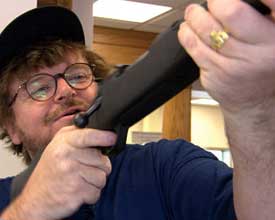| By
now the world’s familiar with the pot stirring shenanigans
of Michael Moore. In Roger & Me it was the documentary
filmmaker’s impossible quest to land an interview with General
Motors head, Roger Smith; in Bowling for Columbine, Moore
chased after former NRA president and  iconic
actor, Charlton Heston; and in Fahrenheit 9/11, he escorted
the mother of a slain GI to Washington, DC to confront President
Bush. With Sicko, Moore continues the trend by loading
up a boat full of 9/11 rescue volunteers afflicted with various
respiratory illnesses and sails them into Guantanamo Bay, propelled
by the premise that the terror suspects held at the notorious US
detention camp are receiving better health care than the 9/11 volunteers. iconic
actor, Charlton Heston; and in Fahrenheit 9/11, he escorted
the mother of a slain GI to Washington, DC to confront President
Bush. With Sicko, Moore continues the trend by loading
up a boat full of 9/11 rescue volunteers afflicted with various
respiratory illnesses and sails them into Guantanamo Bay, propelled
by the premise that the terror suspects held at the notorious US
detention camp are receiving better health care than the 9/11 volunteers.
The
stunts make for amusing cinema, especially with Moore situating
his bulk before the camera, part impromptu referee, part enlightening
commentator and ever ready court jester, but such gimmicks also
carry the tang of exploitation. As Moore pursued Smith
in Roger & Me, the only one with their neck at risk
was the intrepid filmmaker. Impassioned and earnest his unorthodox
in his topsy-turvy stone turning was applauded as a refreshing change
up. Bowling for Columbine too was blessed with a stellar
touching moment as Moore led two boys, both wounded in the Columbine
shootings, into a Wal-Mart to confront the store’s management
about their policy to sell ammunition across the counter with few
restrictions or safeguards. Later, the trio notches victory when
the store pulls ammo stocks from their shelves, but what if it had
gone another way? What if during their time on the road with Moore,
the boys missed too much school, their grades slipped and later,
their families slapped with a suffocating lawsuit by the corporate
superstore? That might make for better onscreen drama for Moore
to rattle his saber at, but at what price to those spurred into
the polemic’s crusade?
For
point of reference, let’s cut into the fast food horror story,
Super Size Me. The fact that filmmaker Morgan Spurlock
plugged himself into the role of human guinea pig and quaffed down
copious amounts of transfat leaden burgers and fries gave the film
instant credibility and a profound sense of intimacy. Now imagine
for a moment that Spurlock had tapped a homeless person in need
of a meal as the one who consumed nothing but McDonald’s super
meals for months on end? At first it might be warming to see a starving
individual eat, but then as malnutrition and life critical measures
like blood pressure and cholesterol veered off the charts and into
the realm of death invoking, how then would Spurlock’s experiment
be received?
Cruel? Exploitative?
Disingenuous?
Somewhere
in the making of Bowling for Columbine, Moore began to
cross that line. It’s there that wafts of the self-aggrandizing,
so stifling in Fahrenheit 9/11, and jury-rigged confrontations,
began to show their unsavory roots. As human and defining a moment
it was to see Moore champion the cause of the two shooting victims
and give them a leg up  in
the healing process, his dogged pursuit of Charlton Heston lacked
integrity and compassion. Sure the former NRA head with a famous
mug would ordinarily be fair game, but at the time confronted, he
had been recently diagnosed with Alzheimer’s. Even applying
a gentle hand, Moore’s takedown of the addled Heston echoed
more schoolyard bully than the righteous vanquisher he embodied
in Roger & Me. And who could forget Lila Lipscomb,
the grieving mother of a soldier killed in Iraq, who after reading
her son’s last letter in Fahrenheit 9/11 is led across
the country to the Washington Mall to exact some form of vindication
from the Bush administration. For all the build up, the payoff never
comes. There’s no cathartic moment. All there is is an emotion-charged
Lipscomb pacing to and fro with the White House looming ominously
in distance. Her wounds are ripped open. Her pain and frustration
are palpable, but the horror that rises to the top is the realization
that she’s ostensibly a carefully positioned pawn in Moore’s
at-all-costs campaign to condemn Bush and the wars in the Middle
East. in
the healing process, his dogged pursuit of Charlton Heston lacked
integrity and compassion. Sure the former NRA head with a famous
mug would ordinarily be fair game, but at the time confronted, he
had been recently diagnosed with Alzheimer’s. Even applying
a gentle hand, Moore’s takedown of the addled Heston echoed
more schoolyard bully than the righteous vanquisher he embodied
in Roger & Me. And who could forget Lila Lipscomb,
the grieving mother of a soldier killed in Iraq, who after reading
her son’s last letter in Fahrenheit 9/11 is led across
the country to the Washington Mall to exact some form of vindication
from the Bush administration. For all the build up, the payoff never
comes. There’s no cathartic moment. All there is is an emotion-charged
Lipscomb pacing to and fro with the White House looming ominously
in distance. Her wounds are ripped open. Her pain and frustration
are palpable, but the horror that rises to the top is the realization
that she’s ostensibly a carefully positioned pawn in Moore’s
at-all-costs campaign to condemn Bush and the wars in the Middle
East.
Sicko
however features the most grandiloquent gem in Moore’s
portfolio of incendiary artifices. As I watched the boat load up
and set sail to Cuba, I was left with questions that had little
to do with what was on the screen. I totally forgot that Moore had
earlier made me stop and wonder if my health care provider could
screw me in some devious way as depicted in his catalog of American
health care horror stories. I forgot about the machinist forced
to choose which of his severed digits he wanted to get sewn back
on his hand because he could not afford them all and the nurse denied
last hope treatment for her otherwise terminally ill husband because
it was “experimental.” I also forgot about all the nagging
“how does it work?” concerns I had as Moore hopped from
Canada to London and France showing us just how rosy social medicine
was at that no one ever had to pay a dime for it. It was all gone
the second that boat drifted across the screen. Instead of questioning
the ills of the American health care system, I was more concerned
with what Moore had said to these people to get them to buy into
his pied piper harbor cruise. Did these people sign waivers indemnifying
Moore from any down stream repercussions, legal suits and so on?
Or did they just blindly trust in Michael? It was then that
I realized the documentary I wanted to see was some sort of alumni
reunion of Moore’s films where the subjects could speak candidly
about their experiences and the process enroute to the final firestorm
on screen. Just think of it, Moore on Moore, it has kind of an Adaptation-esque
surrealism to it.
Still
Moore’s an imposing force. Whether you think he’s a
circus showman or reform minded pundit, his ability to spark debate
is incontrovertible. Wherever he shines his camera talk ensues,
even if it’s talk about Moore being pushy. It’s what
he wants. He’s turned documentary film into a political swaying
power. And it’s a medium that growing. Just look at the amplitude
that Super Size Me and An Inconvenient Truth have
had on such issues as the ills of fast food and the dire need to
preserve the planet’s fragile ecosystem. Moore may gotten
to big to be the kind of documentary filmmaker who can slide in
under radar, but in his last few go rounds Moore and his stunts
have been more press worthy than the issues he has chosen to champion.
A little less Moore and a little more Flint, Michigan (Moore’s
home town depicted in Roger & Me) fire.
-- T.
B. Meek
|






